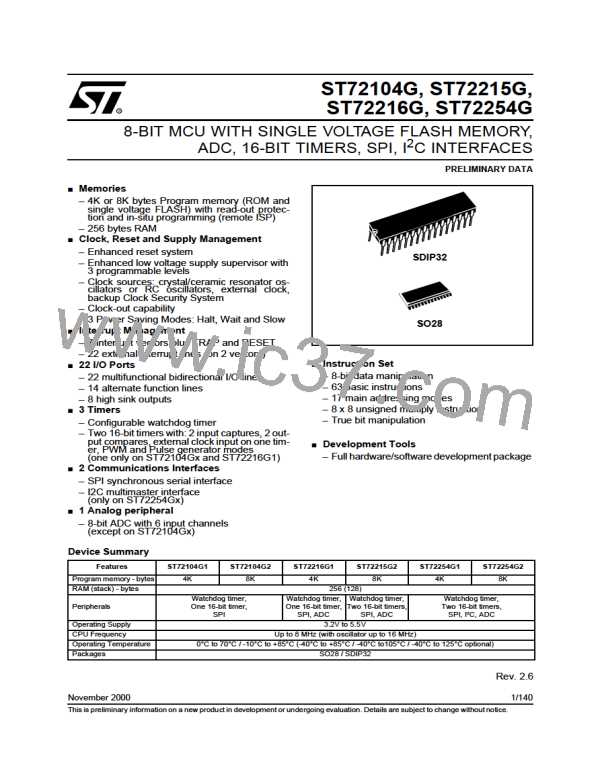ST72104G, ST72215G, ST72216G, ST72254G
13.2 INSTRUCTION GROUPS
The ST7 family devices use an Instruction Set
consisting of 63 instructions. The instructions may
be subdivided into 13 main groups as illustrated in
the following table:
Load and Transfer
LD
CLR
Stack operation
PUSH
INC
POP
DEC
TNZ
OR
RSP
Increment/Decrement
Compare and Tests
Logical operations
CP
BCP
XOR
AND
BSET
BTJT
ADC
SLL
CPL
NEG
Bit Operation
BRES
BTJF
ADD
SRL
JRT
Conditional Bit Test and Branch
Arithmetic operations
Shift and Rotates
SUB
SRA
JRF
SBC
RLC
JP
MUL
RRC
CALL
SWAP
CALLR
SLA
Unconditional Jump or Call
Conditional Branch
JRA
JRxx
TRAP
SIM
NOP
RET
Interruption management
Code Condition Flag modification
WFI
RIM
HALT
SCF
IRET
RCF
Using a pre-byte
The instructions are described with one to four
bytes.
These prebytes enable instruction in Y as well as
indirect addressing modes to be implemented.
They precede the opcode of the instruction in X or
the instruction using direct addressing mode. The
prebytes are:
In order to extend the number of available op-
codes for an 8-bit CPU (256 opcodes), three differ-
ent prebyte opcodes are defined. These prebytes
modify the meaning of the instruction they pre-
cede.
PDY 90 Replace an X based instruction using
immediate, direct, indexed, or inherent
addressing mode by a Y one.
The whole instruction becomes:
PC-2 End of previous instruction
PC-1 Prebyte
PIX 92 Replace an instruction using direct, di-
rect bit, or direct relative addressing
mode to an instruction using the corre-
sponding indirect addressing mode.
It also changes an instruction using X
indexed addressing mode to an instruc-
tion using indirect X indexed addressing
mode.
PC
Opcode
PC+1 Additional word (0 to 2) according to the
number of bytes required to compute the
effective address
PIY 91 Replace an instruction using X indirect
indexed addressing mode by a Y one.
93/140

 ETC [ ETC ]
ETC [ ETC ]